I have been wanting to share this fun way of practicing math for years! As many of you know, we have been using my Minimalist Math curriculum (available free here) all through elementary school. This curriculum removes all the repetition of a traditional curriculum while still covering all the same concepts at all the same levels of difficulty. During the school year, our minimalist curriculum is the foundation of my kids’ math education which we supplement with a weekly logic puzzle and some math games to practice math facts. However, this jeopardy-inspired Game Show Math game has been the star of the summer for YEARS! We use it to review everything they covered the previous year before starting the new year. My kids always ask when they get to start doing it at the beginning of summer!
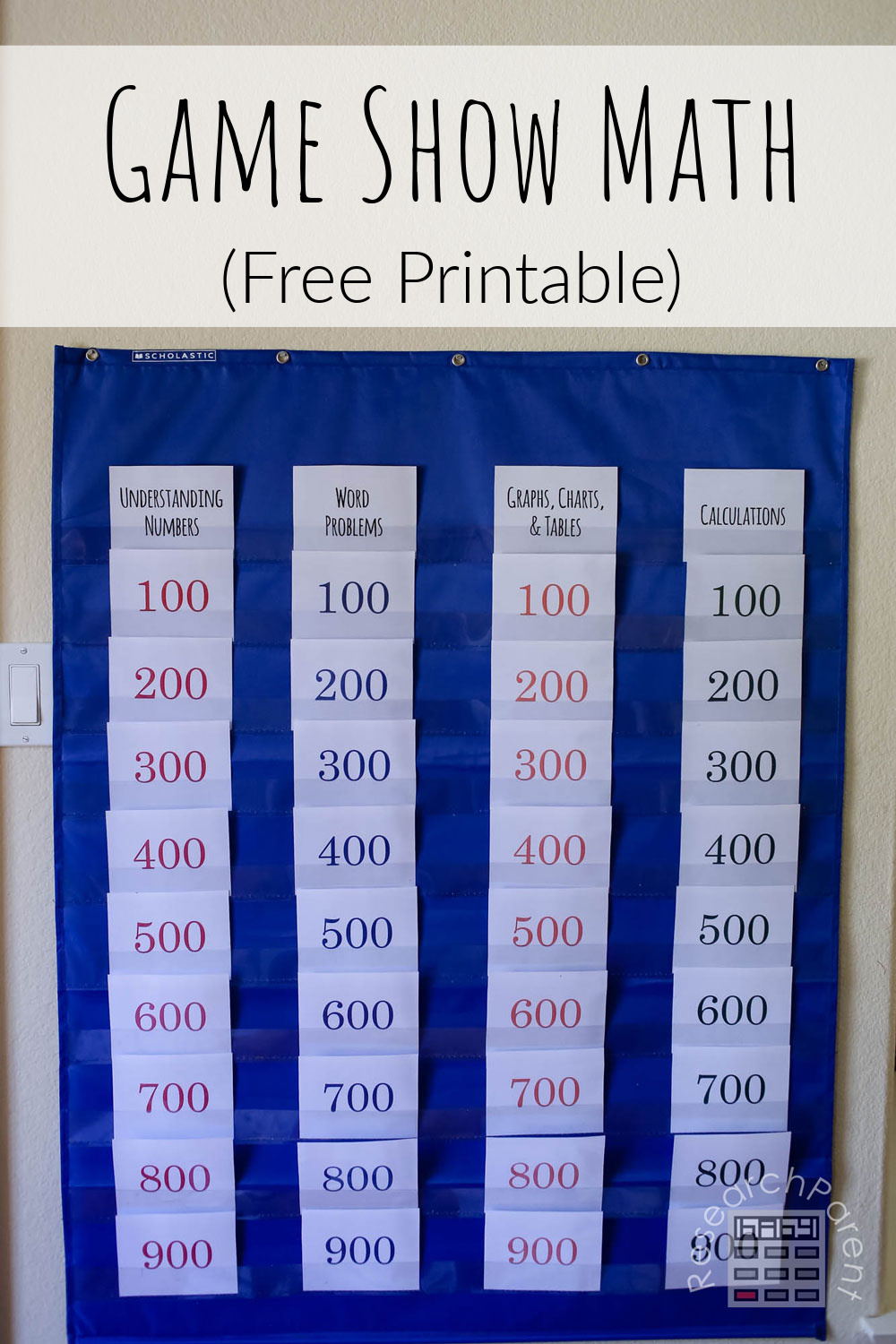
I obviously didn’t come up with the idea of using a pocket chart to create a Jeopardy-style game. Teachers have been doing this forever! My spin was to apply the concept to my Minimalist Math curriculum which is already divided into 10 categories of progressing difficulty for each grade level. It is perfectly suited to this format!
I simply stick a card of increasing difficulty behind each number score. Since I have 4 kids at different grade levels, I actually stick FOUR cards of increasing difficulty behind the numbers corresponding to different grade levels, so that each child gets a card specific to them. My kids then take turns picking a category and number, as in, “Graphs, Charts, and Tables for 600!” In order to increase the amount of math that gets done, ALL of my kids do their question behind the number and have a chance to earn points, not just the person whose “turn” it is.
For the past several years, I have actually made task cards to go along with whatever math curriculum I am creating that year. It is my goal to one day share these cards on this site. I actually started doing that here. However, taking pictures and creating blog posts is time-consuming, especially when I currently have SEVENTY sets of 36 cards (10 for each grade level). This is why I’ve never shared this Game Show Math post before now. Each summer I make a new set of cards and at present, all 7 grade level takes up more than 2 shoeboxes. The idea of taking pictures and making blog posts for them all is overwhelming. 
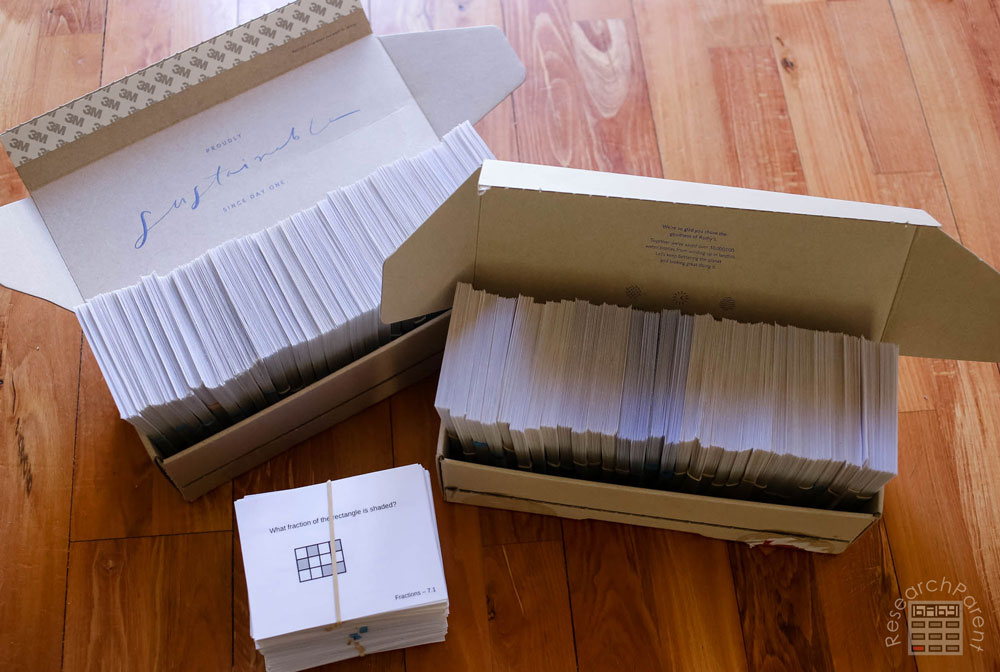
However, the other day I had a stroke of genius. I am currently paying off a lifetime membership to Teachery which allows me to create an unlimited number of courses or hubs. Also, I recently started a Patreon page. I decided to make a “Minimalist Math Library” that houses all my curriculum, answer keys, and task cards (without all the extra bells and whistles of blog posts) and I’m making it available to all those who sign up for my Patreon. By paying $5 to sign up as a Patreon supporter, you can go into any and all grade levels and download all 360 cards. If money is a hardship, you could then cancel Patreon once you have all the cards. Of course, I would love your continued support if you’re able. 
If you don’t want to have to pay for my printable task cards, you could also just use my freely available curriculum or any curriculum you want to write the problems yourself on index cards. This would be time-consuming, but honestly, printing out and laminating all the task cards is time-consuming too! It takes me about 15-20 minutes to laminate just one of the 10 sets which amounts to about 3 hours per grade level of I do them all. (Quality movie-watching time.  ) However, once I do it, I never have to do it again, and I have been using these cards for YEARS. Particularly if you have a lot of kids, it makes so much sense.
) However, once I do it, I never have to do it again, and I have been using these cards for YEARS. Particularly if you have a lot of kids, it makes so much sense.
I hope your family enjoys this math review game as much as we do! (Also, I am currently working on a Minimalist Algebra curriculum. If you’re interested in an Algebra 1 Minimalist Math curriculum and the corresponding task cards, sign up for my newsletter to be notified when it’s ready! Hopefully August 2023.  )
)
Game Show Math Details
Recommended Age Range: Preschool, Kindergarten, Elementary, Middle School
Time Required: we usually play 3 days a week for about 20 minutes over the summer, though the first time you set up the game, I would allow an hour or two to assemble your questions and set up the category and number labels. After the first time you play, it is easier to just restock the questions when needed!
Difficulty: Easy to set up, can be as challenging as you want for students to play
Cost: Free printable categories and labels. About $15-$20 for a hanging pocket chart. All of my task cards for Grades 1-7 can be obtained by becoming a $5 Patreon member. Or you can make your own task cards by writing on index cards! If you choose to laminate everything, that could add an extra $10-15 per grade level.
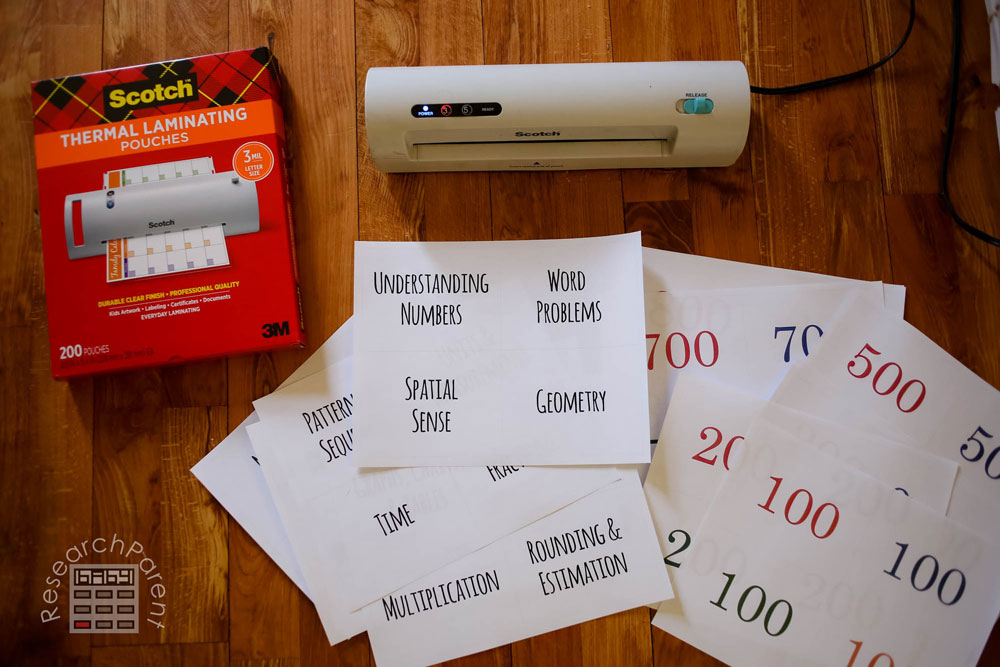
Materials
- Free printable categories and labels
- Pocket Chart (This one is 34″ x 44″ like the one I use. However, a narrower one would also work. The cards would just be closer together.)
- Laminating sheets
- My Patreon Minimalist Math Task Cards (optional, could also write problems on index cards)
Supplies
- laminator
- scissors
Instructions – Setting Up
- First, download and print pages 2-16 of the free printable categories and labels document. I recommend laminating them for durability.
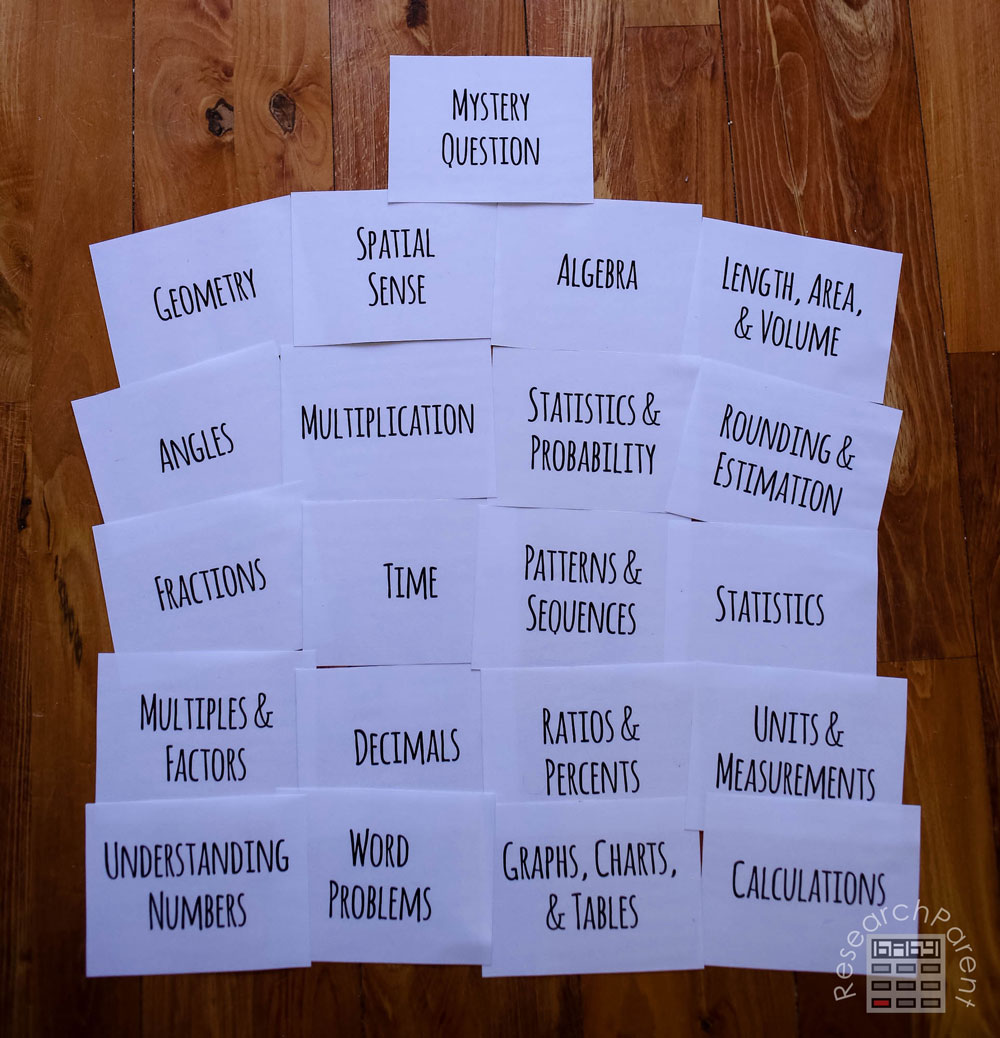
- If you haven’t already, hang up your pocket chart.
- Decide which categories of questions you want to include in your game and place them along the top row. Place the numbers underneath as shown.
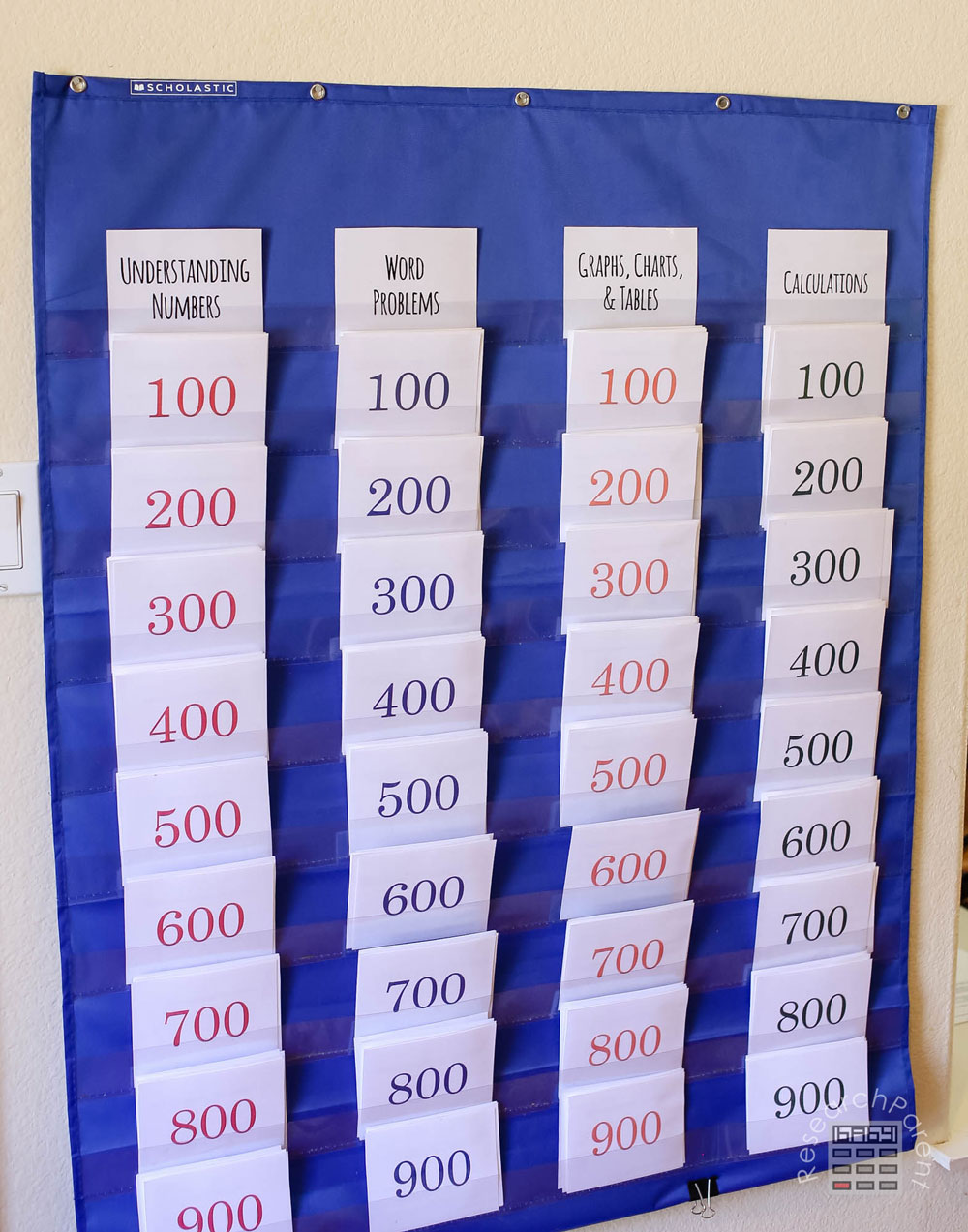
- The next step is to decide on which questions to use! The easiest way to do this is to get my printable task cards that are included in my $5 Patreon membership. However, you could also take my free Minimalist Math curriculum and copy some problems onto index cards. Each problem number is a different category of question. For example, on all 7 grade levels, problem 1 is the category Understanding Numbers and covers foundational math knowledge and skills.
- Choose 9 problems from each of the 4 different categories to include in the first iteration of your game. At the beginning of the summer, I always start by choosing questions 11 through 19 from my task cards (or curriculum). This way, if the questions are too hard, the next day I can go back and choose easier (lower number) questions. Starting in the middle also makes it more likely we reach the end of the cards by the end of summer.
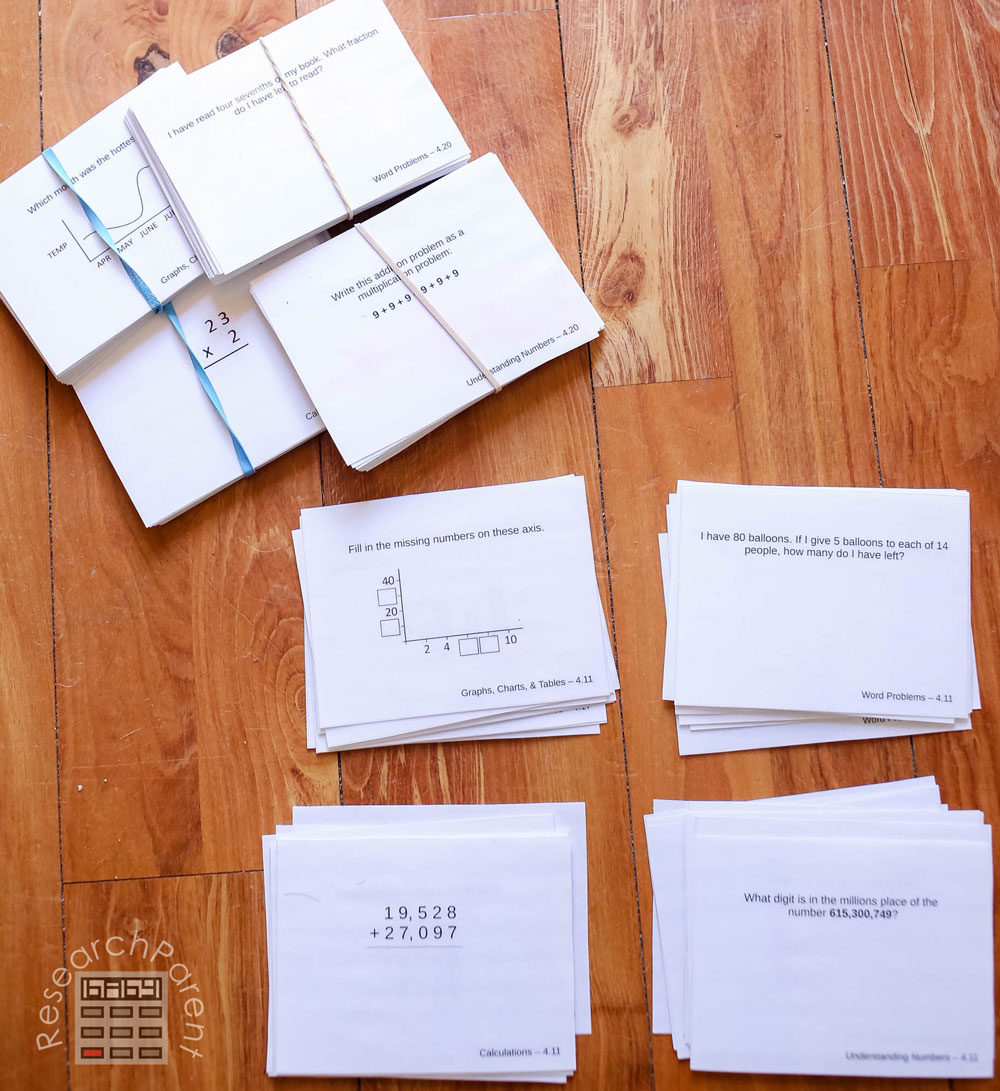
- Place the question cards behind the numbers on your board. If you have more than one child, you may want to place multiple question cards behind each number so each child has an appropriate question. This is what I do with my own kids. This year I am pulling the same card number from 4 different grade levels (1, 3, 5, and 7). That way, if someone chooses “Calculations for 400” each of my kids will have an age-appropriate problem to work on and try to score points.
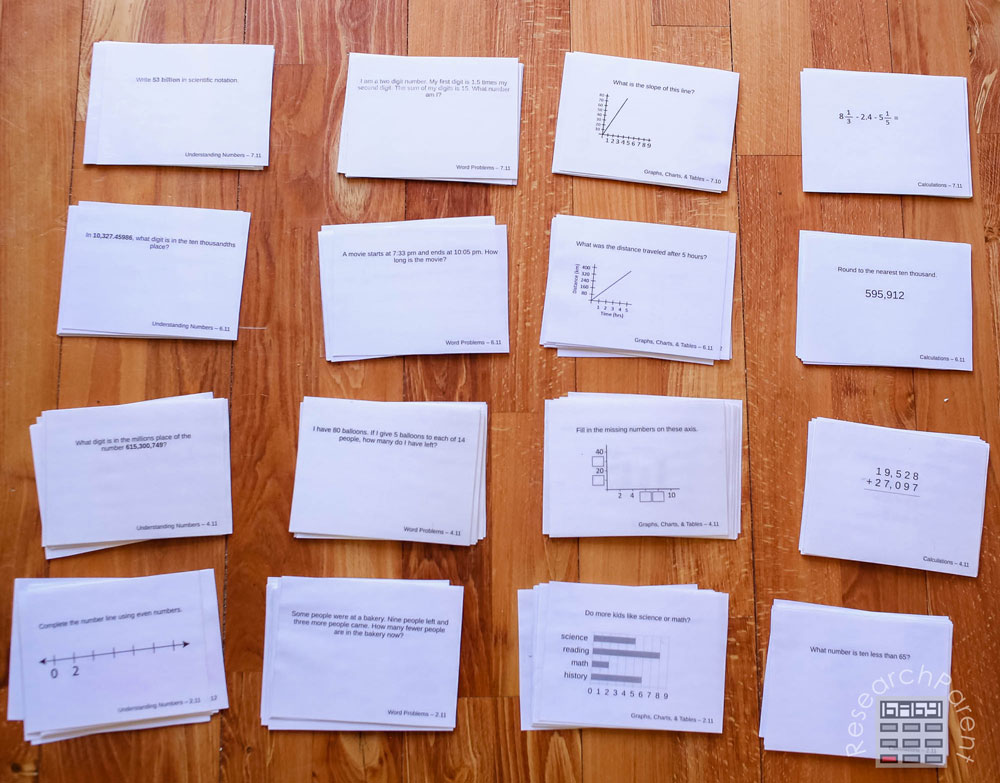
Instructions – Playing the Game
- In our family, the youngest goes first, then we play youngest to oldest.
- On each person’s turn, the player will choose a category and a number. The numbers correspond to the maximum number of points that a player can earn.
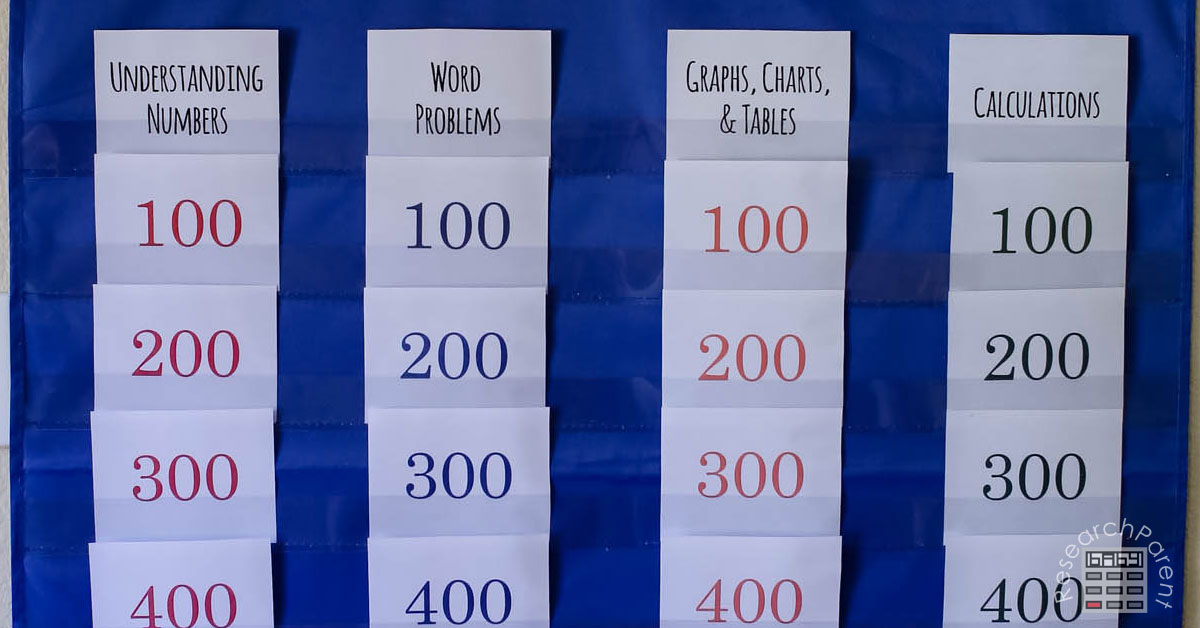
- Once the player has chosen the category and number, I (the parent/teacher), pull out all the cards in that slot. I then read the question on each card aloud and hand it to the appropriate player. I particularly like reading the younger kid questions aloud, because a) my younger kids are not strong readers, so it helps them to be successful and b) I feel like it is useful for my older kids to hear what my younger kids are doing just to jog their memories and get them thinking, “Oh, that’s easy, I can do that.”
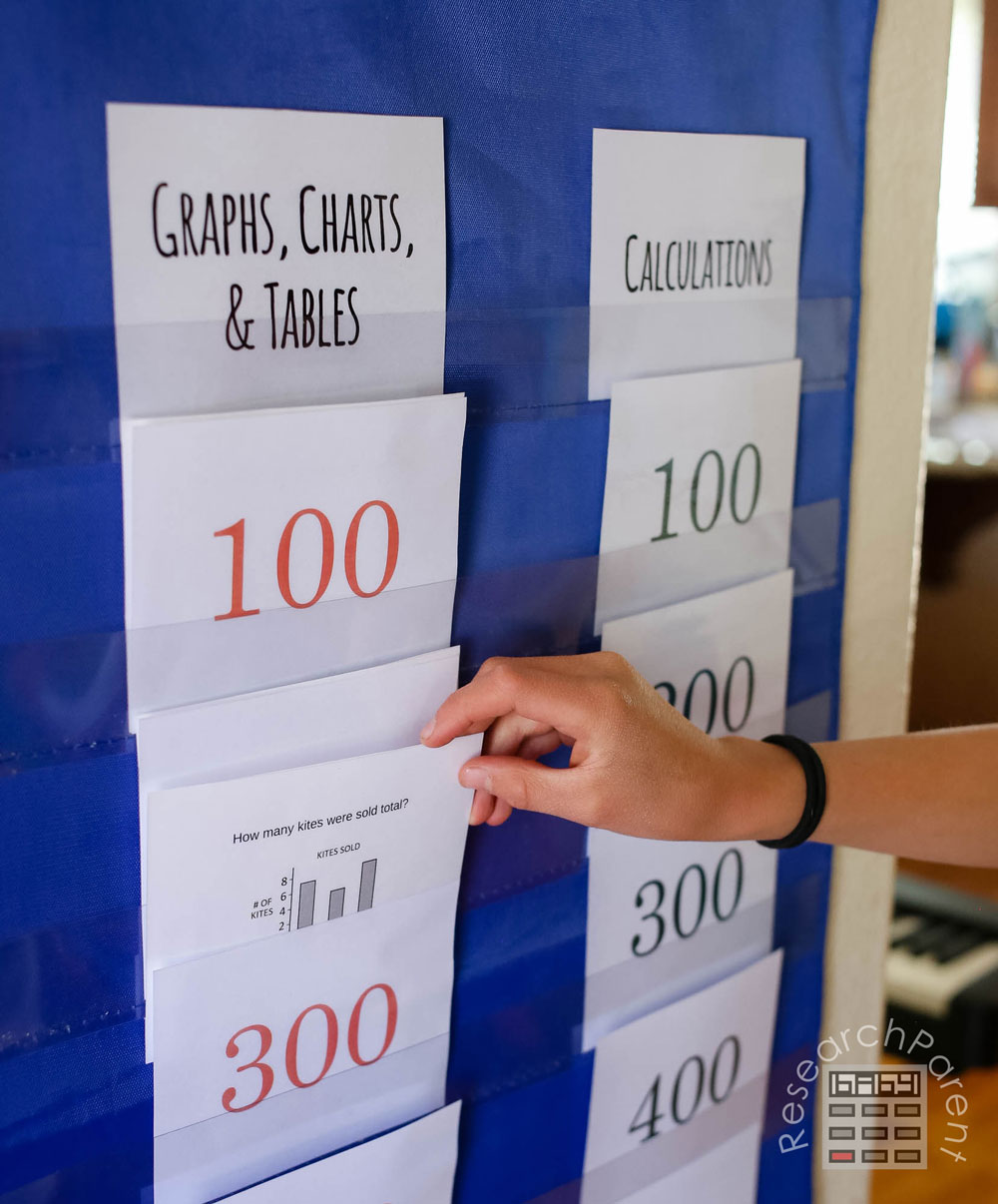
- Once I pass out all the cards, I flip around the number so that we know that slot has already been used.
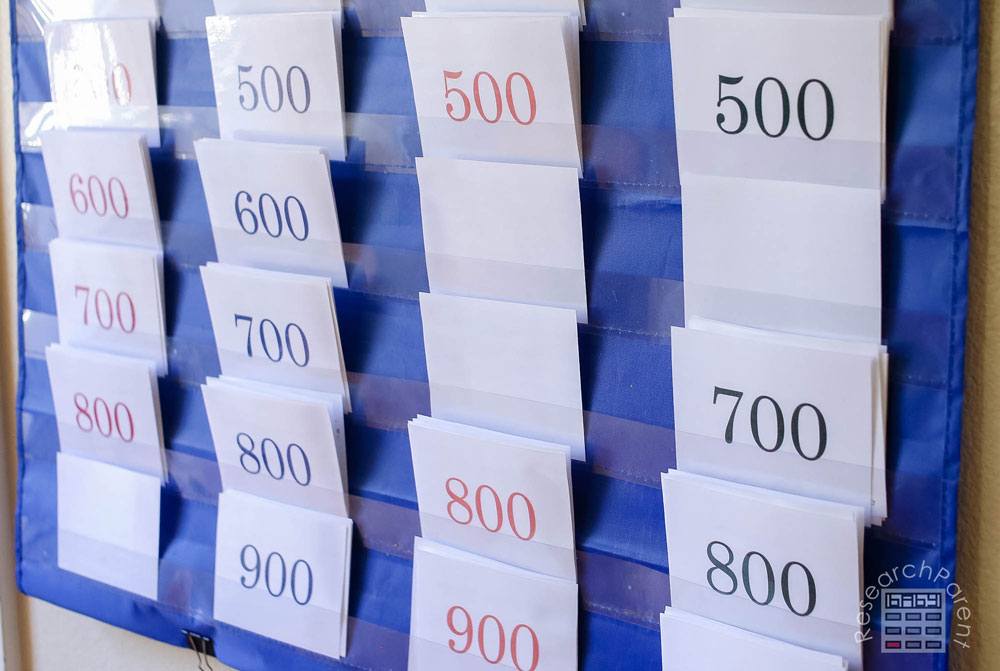
- The children each work on the question on their own. Some do it directly on the card with a whiteboard marker. Some use their own little whiteboard. (These are the ones we have.) Some do it on paper. If they don’t need any help and get the correct answer, they earn full credit. If they get the wrong answer and want to try again, I deduct 50 points. If they need a hint, I deduct 50 points per hint. (The umm…helpfulness, shall we say… of the single hint depends on how far ahead or behind that particular player is in the game. I like to keep things close.
 ) Basically, it is a 50-point loss for every intervention with a minimum of half credit. Even if I end up needing to do every single step, they still get half credit if they follow along until they understand.
) Basically, it is a 50-point loss for every intervention with a minimum of half credit. Even if I end up needing to do every single step, they still get half credit if they follow along until they understand.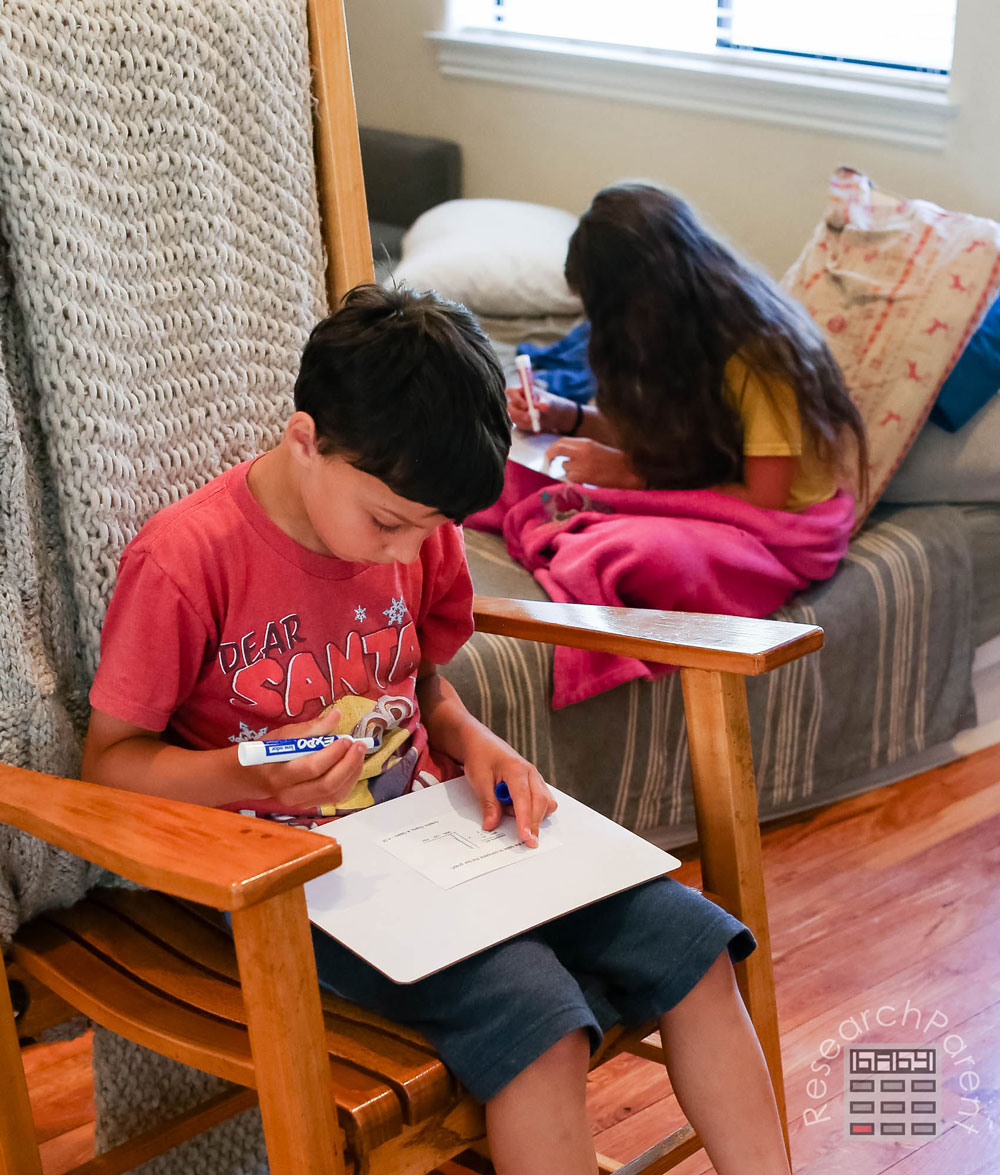
- We keep score on our whiteboard, but you could keep score on paper if that’s easier. My kids each made up aliases since I wanted to take a picture. These are not their real names.

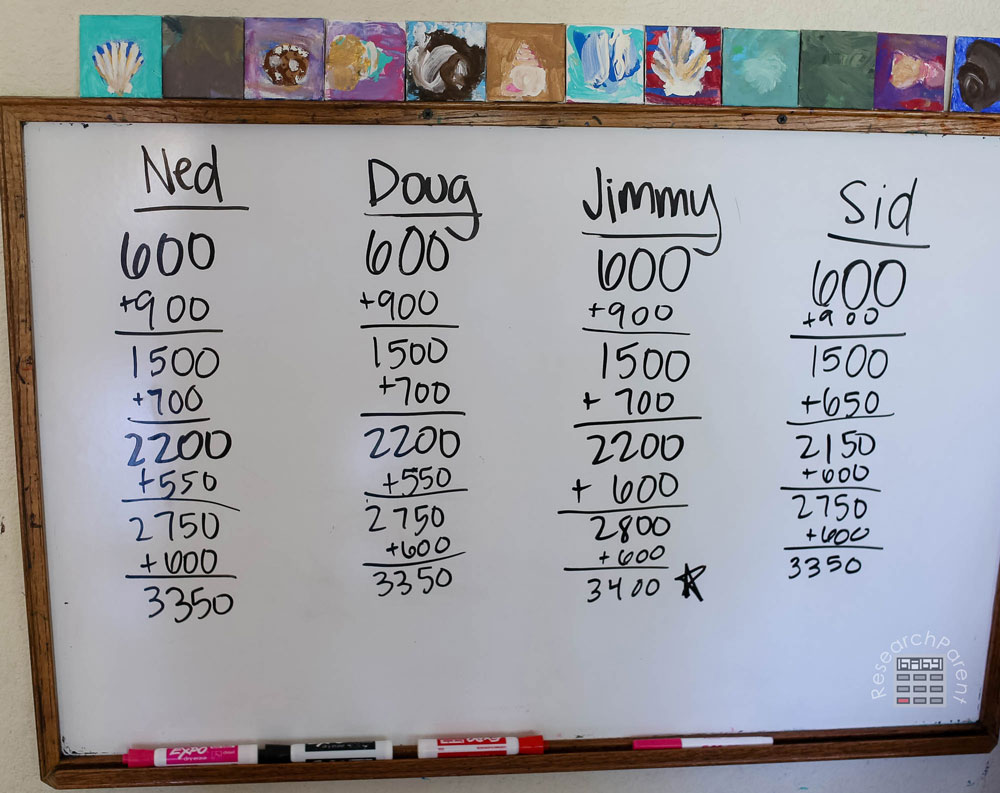
- Once the kids have completed the cards, I do one of two things with them. If I feel like they don’t need to see that question again this summer (which is the majority of them), I put them in a messy, used stack that I sort at the end of the summer when I put the cards away. I love seeing this stack grow over the weeks. If I feel they would really benefit from doing that exact problem again in the following days, then I will put it back on the board in the same slot it was originally in. (Tip: Don’t forget to erase the whiteboard marker from the cards right away, because after a few weeks, it will be hard to get off!)
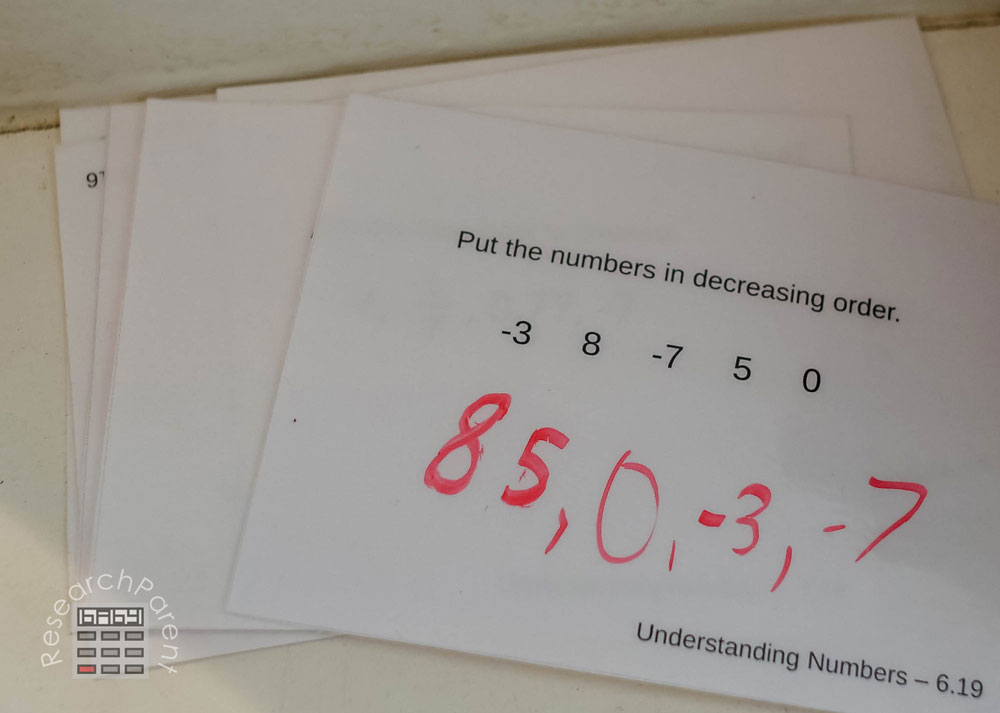
- We usually only get through about 6 to 8 questions in a day, so I keep the same board up for a few days or sometimes the whole week. Once there are not many questions left or the whole lower half of the board has been completed, then I will shift any incompleted questions up on the board and then add new harder questions to the bottom!
That’s basically it! If you have any questions, feel free to let me know!
Click here for all the Minimalist Math curricula available for different grade levels.
Related Links
Math Activities for Kids
Minimalist Math Curriculum Methodology
Learning Activities for Kids
The post Game Show Math appeared first on ResearchParent.com.
